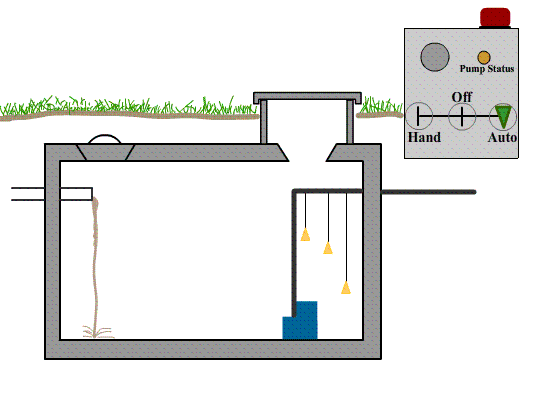
The drawing shows a ‘typical’ demand flow pump installation for a residential sewage system in Virginia. For many years this was essentially the only type of pump system available to homeowners. It’s still a very common type of system so we will use it as the starting point for explaining how pump systems work.
The system consists of several important parts. Let’s start with the pump chamber. 1,200 gallon septic tanks are commonly used but depending on what you are trying to accomplish the tank may be larger or smaller. Effluent flows into the pump chamber from the septic tank. In this case the septic tank is located off to the left out of sight. The septic tank liquifies the wastewater and retains most of the solids. This is important because most effluent pumps cannot pass large solids and in any event, we don’t want to send solids to the drainfield where they can damage the absorptive interface of the soil.
The blue box like object at the bottom of the tank is the pump. These vary in size depending on how far you will be pumping, how high you need to lift the effluent, and the reason you are pumping. Some systems just need to overcome an elevation difference while other systems use the pump to distribute effluent evenly. These later systems usually need to have a little more power to pressurize piping. In general, it’s rare to see a pump smaller than 1/4 horse power or larger than 1/2 horse power on a residential system.
Next to the pump are three float switches. The lowest float is the “pump enable/off” float. In the ‘up’ or ‘on’ position it enables the pump to run. This means the pump can run when the middle or pump ‘on’ float also tips to the on position. After the pump ‘on’ floats tips back down the pump will continue to run until the lower float turns the pump off. In normal operation, effluent from the septic tank fills the pump chamber and the pump controls keep the effluent between the two lower floats.
These floats are typically set to discharge a volume of effluent somewhere between the daily flow from the house and one-quarter of the daily flow. For a four bedroom house this means between 150 and 600 gallons of effluent per dose. This volume is set by changing the distance between the two floats. Since most 1,200 gallon septic tanks have a liquid depth of 48″, each inch of liquid depth amounts to about 22 gallons. This means the floats should be set between 7 and 22 inches apart.
Normally the floats are closer to 7″ distance than 22″ value . The reason is one of the other goals in designing the system is keeping the pump constantly submerged. Sewage is somewhat corrosive but sewer gasses are even more corrosive. Keeping the pump covered with effluent slows the corrosion process. A bigger tank would allow a greater pumping volume but the larger tank is more expensive and there is no advantage to a bigger dose, only greater cost.
The top float is a high water alarm. If for some reason the pump does not start when the ‘on’ float tips up, the high water alarm will give an audio visual alarm to signal the user that there’s a problem. In Virginia, systems are designed to have one quarter of a day storage above this alarm. With strict water conservation methods this can be stretched to a day or more. Exactly how long until the tank fills depends on the number of people using the system, the size of the tank, how strict the users are with their water use and other variables.
